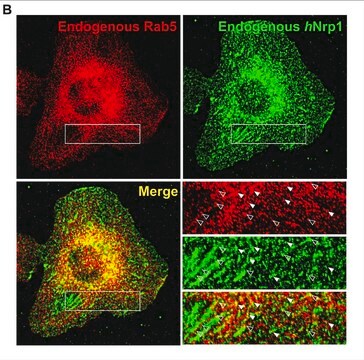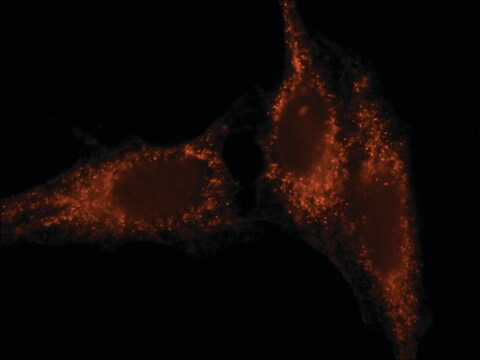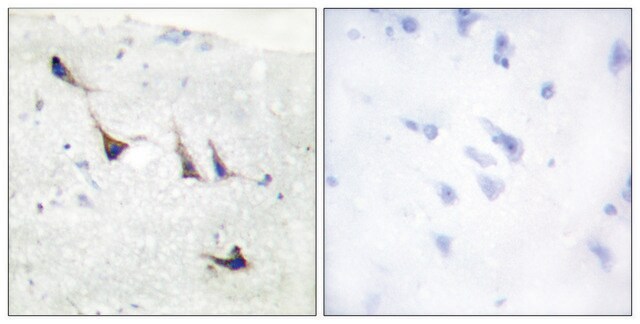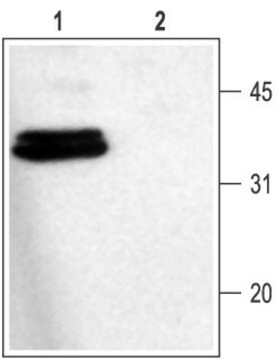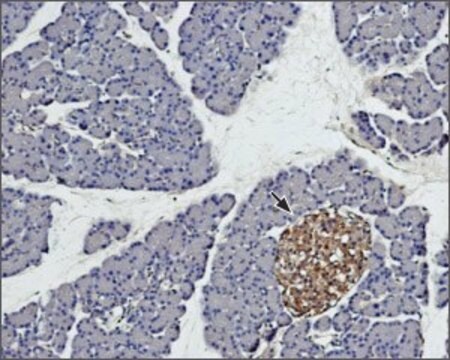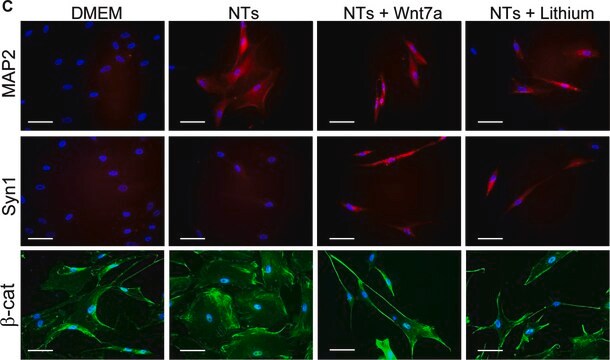推荐产品
生物源
mouse
品質等級
共軛
unconjugated
抗體表格
ascites fluid
抗體產品種類
primary antibodies
無性繁殖
HPC-1, monoclonal
分子量
antigen 35 kDa
包含
15 mM sodium azide
物種活性
rat, bovine, rabbit
技術
immunocytochemistry: suitable using monolayer cultures of neonatal retina cells
microarray: suitable
western blot: 1:2,000 using crude preparation of synaptic vesicles from rat cerebral cortex
同型
IgG1
UniProt登錄號
運輸包裝
dry ice
儲存溫度
−20°C
目標翻譯後修改
unmodified
基因資訊
rat ... Stx1a(116470)
一般說明
Monoclonal Anti-Syntaxin (mouse IgG1 isotype) is derived from the hybridoma produced by the fusion of mouse myeloma cells and splenocytes from an immunized mouse. Syntaxin (also cited as HPC-1 antigen), a 35 kDa molecule with carboxyl-terminal membrane anchor is a synaptic protein. Syntaxin 1 is a membrane protein. Neurons express syntaxin 1A.
Syntaxin is a 35kD synaptic protein capable of interacting with the synaptic vesicle protein synaptotagmin. It facilitates the docking and fusion of synaptic vesicles with the plasma membrane. Monoclonal anti-syntaxin antibody can be used to screen λ gt 11 library of rat hippocampus to isolate syntaxin cDNA clones. It can also be used in microarray and immunocytochemistry. Mouse anti-syntaxin antibody reacts specifically with membrane protein syntaxin (35 kD). The product has also shown cross reactivity for rabbit, rat and bovine but not for guinea pig.
免疫原
synaptosomal plasma-membrane fraction from adult rat hippocampus.
應用
Monoclonal Anti-Syntaxin antibody produced in mouse has been used in:
- immunoblotting
- immunohistochemistry
- immunoprecipitation from hippocampal lysate
- immunohistochemical analysis
Monoclonal anti-syntaxin antibody can be used in immunoprecipitation and immunohistochemistry. It can also be used in western blotting. Further, this product can also be used to label monolayer cultures of neonatal retinal cells and frozen paraformaldehyde fixed tissue sections.
生化/生理作用
Syntaxin 1 (STX1A) may control exocytosis in synaptic vesicles. In retina, STX1A may help in the structural formation of the inner nuclear layer (INL) and outer plexiform layer (OPL). Deletion of STX1A in mice affects the functions of hypothalamic-pituitary-adrenal axis. It may participate in spinal nociceptive plasticity promoted by peripheral nerve injury. It has been implicated in docking at synaptic vesicles of presynaptic neurotransmitter release sites.
免責聲明
Unless otherwise stated in our catalog or other company documentation accompanying the product(s), our products are intended for research use only and are not to be used for any other purpose, which includes but is not limited to, unauthorized commercial uses, in vitro diagnostic uses, ex vivo or in vivo therapeutic uses or any type of consumption or application to humans or animals.
未找到合适的产品?
试试我们的产品选型工具.
儲存類別代碼
10 - Combustible liquids
水污染物質分類(WGK)
WGK 3
閃點(°F)
Not applicable
閃點(°C)
Not applicable
W Liu et al.
Biophysical journal, 91(2), 744-758 (2006-05-02)
Exocytotic release of neurotransmitters is mediated by the ternary soluble N-ethyl maleimide-sensitive fusion protein attachment protein receptors (SNAREs) complex, comprised of syntaxin (Sx), synaptosome-associated protein of 25 kDa (SNAP25), and synaptobrevin 2 (Sb2). Since exocytosis involves the nonequilibrium process of
M Tagaya et al.
The Journal of biological chemistry, 270(27), 15930-15933 (1995-07-07)
Syntaxin 1 (HPC-1), a component of the receptor for SNAPs (soluble N-ethylmaleimide-sensitive factor attachment proteins), has been implicated in the docking and fusion of synaptic vesicles with the plasma membrane. It was reported that syntaxin 1 in rat brain and
The AMPA receptor GluR2 C terminus can mediate a reversible, ATP-dependent interaction with NSF and alpha-and beta-SNAPs
Osten P, et al.
Neuron, 21(1), 99-110 (1998)
Neuron-like differentiation and selective ablation of undifferentiated embryonic stem cells containing suicide gene with Oct-4 promoter
Hara A, et al.
Stem Cells and Development, 17(4), 619-627 (2008)
Masataka Kunii et al.
The Journal of cell biology, 215(1), 121-138 (2016-10-05)
The membrane fusion of secretory granules with plasma membranes is crucial for the exocytosis of hormones and enzymes. Secretion disorders can cause various diseases such as diabetes or pancreatitis. Synaptosomal-associated protein 23 (SNAP23), a soluble N-ethyl-maleimide sensitive fusion protein attachment
我们的科学家团队拥有各种研究领域经验,包括生命科学、材料科学、化学合成、色谱、分析及许多其他领域.
联系技术服务部门